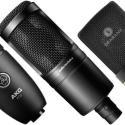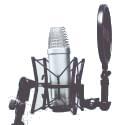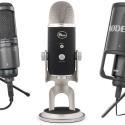Mic Polar Patterns: Let's Explain How They Work
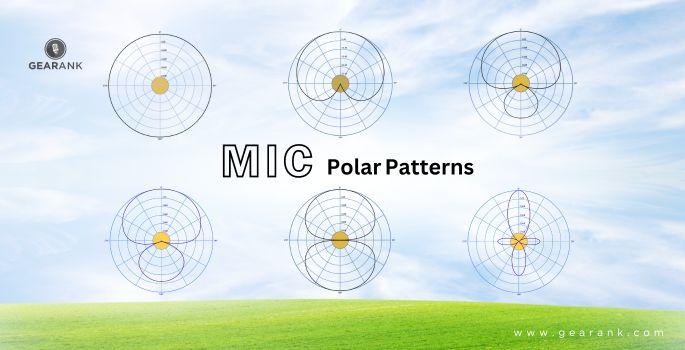
If you've just started recording, something you'll have probably come across by now are polar patterns. And these are worth knowing about, as microphone polar patterns can make all the difference when it comes to good and bad recordings.
So why is choosing the right polar pattern important?
Depending on the polar pattern, microphones are designed to be sensitive to sounds coming from specific directions. Some mics are better for recording the sound source it's pointed at, while other mics are better for recording sounds from all around the room.
So getting to understand microphone polar patterns is key to knowing what the best microphone is for what you need to record.
For everything you need to know about microphone pickup patterns, this guide runs through an explanation of polar patterns and the different types of polar patterns.
What are Microphone Polar Patterns?
A microphone polar pattern refers to how sensitive the microphone is to sound in relation to where sound waves are coming from. And this is graphically represented in polar pattern charts.
All microphones convert sound waves to an electric signal, i.e. an audio recording. But what sounds are picked up and recorded by the microphone will depend on its pickup pattern.
A microphone's polar pattern have 3 features:
-
Directionality
-
Sensitivity
-
Rejection
1. Directionality
Some microphone patterns are designed to pick up sound from one direction: where the mic is pointed. On-axis means that the sound source is directly in front of the diaphragm or the transducer of the mic. Whereas, off-axis entails that the sound source is not in the front of the mic.
Other microphone patterns are better for picking up sounds from different angles - regardless of where the mic is pointed.
As a result, some polar patterns are better in certain applications. There might be times when you just want to record an isolated sound, like a kick drum or vocal, while other times you might want to record different sounds happening all around the room or the environment.
2. Sensitivity
A microphone isn't just sensitive to the direction where the mic is pointed at. The polarity also affects the frequency response of a mic and how it captures sound. On-axis, the sound is more accurately captured especially if the right distance between the sound source has been established.
This is why it's important to gauge where the sweet spot of the mic is. Some polar patterns tend to have more proximity effect than others. Proximity effect is a phenomenon that occurs when the sound source gets closer to the microphone, the low frequency response accumulates or increases.
Sounds that are captured in the off-axis of the polarity will also "colour" the sound. This is why it's important to gauge where the sweet spot of the mic is.
3. Rejection
A mic's effectiveness is not just measured in terms of its sound sensitivity. Polar patterns are utilized well if you know where it's least sensitive to sound. Certain recording situations demand specific polar configurations. Sound variables such as noise and ambient sounds aren't ideal if the end goal is to record the interviewer.
This is where sound isolation comes in. Depending on the direction the mic is pointed at, certain polar patterns will be receptive towards the sounds in front of it, while still being able to capture sounds around it minimally.
Mic Polar Patterns You Should Know
There's a handful of mic polar patterns you should know if you plan on recording something specific or just want to improve the quality of your recordings overall.
These polar patterns include:
-
Cardioid
-
Supercardioid
-
Hypercardioid
-
Figure 8
-
Omnidirectional
-
Shotgun
And these are the 3 most common polar patterns you'll most likely encounter:
-
Cardioid
-
Omnidirectional
-
Figure 8
The list might seem confusing for now, but I'll explain what these pickup patterns are below.
1. Cardioid Polar Pattern
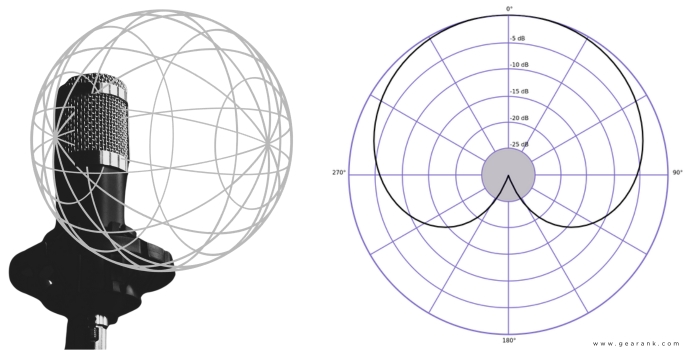
The cardioid pickup pattern is the most common polar pattern found in dynamic mics. Cardioid mics have directional polar patterns. The cardioid is sensitive to the sounds pointed directly at the transducer, and has strong rejection at the back of the mic. In other words, a cardioid pattern is best for recording a single sound source coming from one direction.
A cardioid microphone is best used in situations where isolating the sound is needed. This can include:
-
Vocals
-
Guitar amps
-
Different parts of a drum kit like a snare, tom, or kick drum.
For this reason, cardioid microphones are great vocal mics in live situations, as well as ideal for avoiding reverb and ambient sound on recordings - since the mic will largely pick up sound from where it's pointed.
2. Supercardioid Polar Pattern
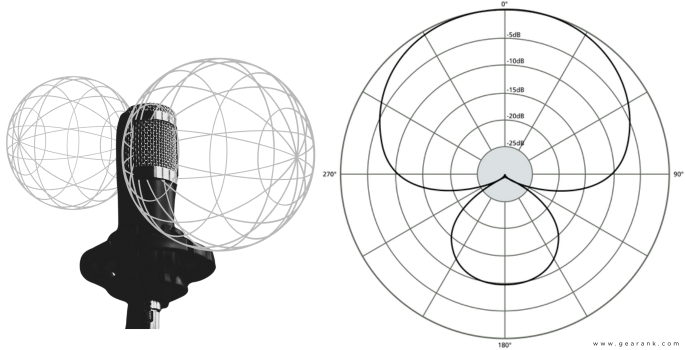
If the name doesn't give it away, super-cardioid polar patterns are similar to the cardioid polar pattern. A super-cardioid mic is better at isolating the sound it's pointed at, with less sensitivity at the sides of the mic.
Supercardioid mics will also pick up sound from the opposite direction they're facing. So this polar pattern is a great choice for isolating and better capturing desired sound sources with more clarity and gain.
Live recordings can sound a bit more natural due to the spill of other sounds getting picked up in the rear. This can be a good thing if some ambiance is desired, though, especially when recording vocals and drums.
3. Hypercardioid Polar Pattern
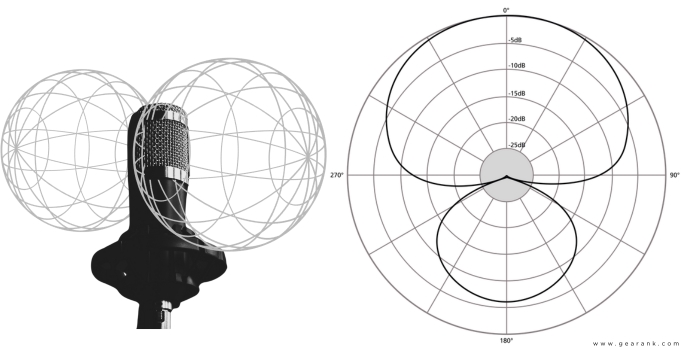
Hypercardioid polar patterns take things one step further than supercardioid mics. They have a similar polar pattern shape but are much more sensitive at the front with some extra bleed from the rear.
As a result, hyper-cardioid is also called unidirectional polar pattern. This means that hyper-cardioid microphones are also called unidirectional microphones that are even better at minimizing sound captured from the sides, with greater isolation of the sound source they're pointed at. This makes them ideal for drums and, in some situations, vocals.
Still, sound captured from the rear of the mic is more noticeable with hypercardioid mics - something to be aware of whenever they're used.
What mics typically have a cardioid polar pattern?
-
Dynamic mics
-
Condenser mics
-
Multi-Pattern mics
The downside with these 3 polar patterns is that, the proximity effect can be prominent as you get closer to the mic. This will muffle the sound and also introduce harsh plosives such as t,sh, ch, and so on. Gauge the right distance from the mic and you won't encounter any of these issues.
4. Figure 8 Polar Pattern
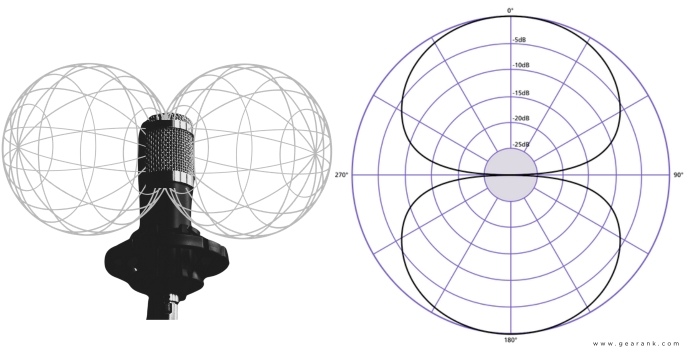
The Figure 8 polar pattern, also called the bidirectional polar pattern, is a mic polar pattern that captures sound equally in both the front and rear and rejects all sounds coming from the left and right. For two sound sources that are placed opposite one another, the bidirectional polar pattern is a popular choice for stereo miking techniques.
It's worth noting that bidirectional microphones can be used as a simple option for podcast recordings where two guests are facing each other, or in live performances with a singer and a guitar.
What mics typically have an omnidirectional polar pattern?
-
Ribbon microphones
-
Multi-pattern mics
5. Omnidirectional Polar Pattern
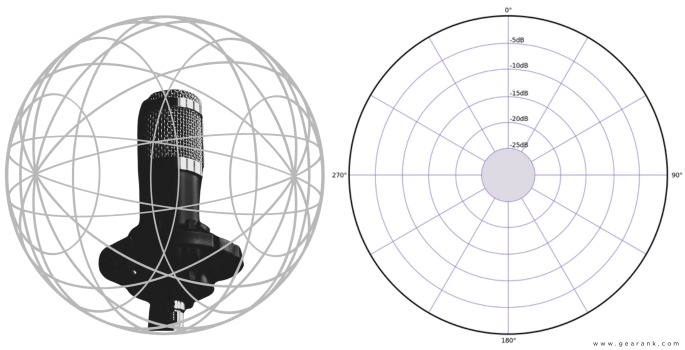
If you know what "Omni" means, then you'll have a good idea of what an omnidirectional microphone does. I'd call it the "360 camera" of audio. Omnidirectional microphones capture sounds from all directions, regardless of where they're pointed.
Omnidirectional mics are great for acoustically-treated environments. Since directionality isn't an issue, it has little to no proximity effect and plosive sounds aren't as harsh compared to directional polar patterns.
The omnidirectional pickup pattern is excellent for recording:
-
Room ambiance and environmental sounds.
-
Moving sound sources.
-
Single or group vocals.
-
Drum overheads.
Omnidirectional mics also have great, but sensitive bass response, since they'll pick up low frequencies resonating around the room easily. The downside? It doesn't isolate sound. It has a high tendency to capture sound sources even outside its polar pattern. Omni mics will pick up unwanted sound sources, plus reflected sound coming off walls.
What mics typically have a shotgun polar pattern?
-
Large and small diagram condenser mics
-
Multi-Pattern mics
6. Shotgun Polar Pattern
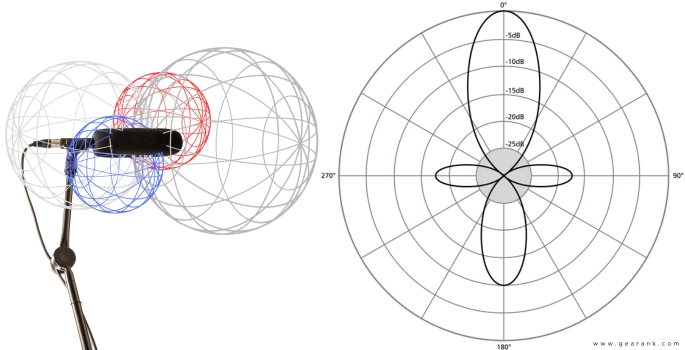
The shotgun polar pattern (also called lobar polar pattern), is used by the common shotgun mic. As the name suggests, the shotgun pattern is super sensitive to sound from the front, with very little sensitivity to sound at the sides.
As a result, shotgun microphones are thin mics with directional patterns that are highly focused. This makes them common in film production and also vlogging, where voices must be captured with very little background noise.
7. Multi-Pattern Microphones

Multi-pattern mics are the Swiss army knife of audio. They can switch polar patterns to adapt for different purposes. Multi-pattern mics are great for people who want to record with the same mic but with a different polarity. This is especially important in productions where a uniform sound is needed and switching from one mic to another produces different tonal outcomes.
This also allows greater room for experimentation when recording, and can also save you money if you don't have the budget to purchase separate microphones with different polar patterns.
If you are new to recording, opting for a multi-pattern mic can even be a great way to familiarize yourself with the different patterns before investing in a mic with a specific polar response, such as a cardioid pattern, omnidirectional pattern, shotgun microphone pattern, or any other polar pattern. Note that most multi-pattern mics are condenser types, this is an important aspect when choosing between dynamic vs condenser mic options.
Final Thoughts
To wrap everything up conveniently, you can think of polar patterns in terms of the direction they capture the signal.
-
Three cardioid patterns (cardioid, supercardioid, hypercardioid) increase in rear sensitivity and sound isolation.
-
You can think of Figure 8 or bidirectional polar pattern, as a "maxed out" version of the cardioid where the front and rear are equally sensitive. The sides, rejected.
-
Omnidirectional polar pattern hears everything, rejects nothing.
All in all, a microphone's polar pattern refers to how sensitive it is to sound in relation to where it's pointed. No recording session is the same, so it's worth getting to know these polar patterns if you want to achieve the best recordings possible.
Contributors:
- Allen Articulo - Co-writer
- Jerry Borillo - Illustrator




